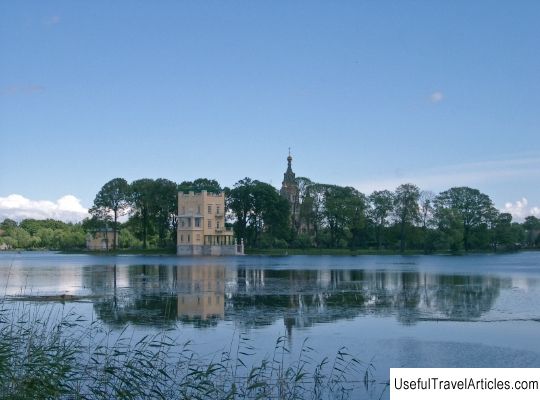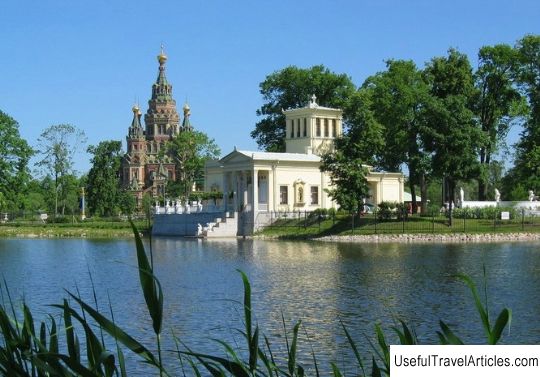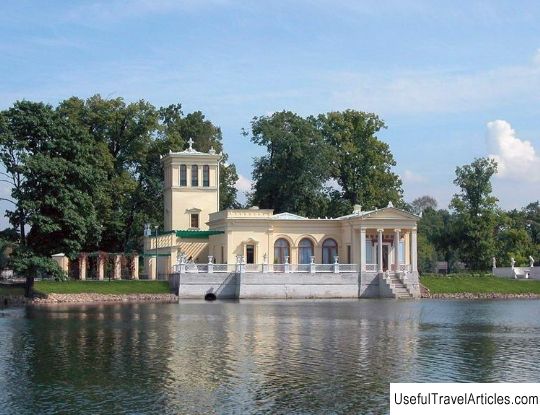Holguin pavilion description and photo - Russia - St. Petersburg: Peterhof
Rating: 8,5/10 (387 votes) 
Holguin pavilion description and photos - Russia - St. Petersburg: Peterhof. Detailed information about the attraction. Description, photos and a map showing the nearest significant objects. Photo and descriptionThe Holguin pavilion is located in Peterhof and is an example of an entertainment structure of the mid-19th century. It is located on an island in the middle of Olginoye Lake in the Kolonist Park, next to the Tsaritsin Pavilion. The pavilion was built in 1846-1848. for Grand Duchess Olga Nikolaevna, daughter of Emperor Nicholas I according to the project of A.I. Stackenschneider. In its appearance, the Holguin pavilion resembles a southern Italian villa. The slender structure, topped by a flat roof, is set on a plinth rising out of the water. A platform with a trellis wooden canopy was made on the roof of the pavilion. The smooth yellow painted walls of the pavilion bring white bas-reliefs, balconies, busts and dragon-shaped gutters down from the roof to life. The entrance to the pavilion is located on the north side of the building. Through a small hallway, past the stairs, you can get to the dining room. The interior of the dining room is decorated rather modestly: the lower part of the wall panels is painted like marble, and the walls are decorated with simple murals with ornaments (artist I. Drollinger) and light molded rods. The coffered ceiling is also painted by Drollinger. The fireplace in yellow and white marble was made in the workshop of A. Triscorni. On the fireplace there is a gilded bronze clock and luxurious tall candelabra. As a reminder of the owner of the pavilion - the portrait of the Grand Duchess by P.N. Orlova. On it, the artist captured Olga Nikolaevna in 1846 against the background of a villa in Palermo. The table next to the fireplace is served with dishes from Olga Nikolaevna's dowry - deep and dessert plates, soup bowls, made at the Imperial Porcelain Factory in 1846. Next to the porcelain service are plates and dishes with lids from a silver service. Each of them is decorated with the monogram `` ON '' Directly to the dining room there is a pantry, which also displays dishes from the dowry of the Grand Duchess. On the opposite side was a small toilet room. Through one of the doors of the dining room, one could go to a staircase descending to the water and get into a gondola or boat. The second floor is occupied by the hostess's office. From it you can go to a balcony and a small terrace, as well as go down to the garden by an external staircase, which is decorated with a marble vase. The cabinet is decorated with Russian furniture of the mid-19th century. Among other items on Olga Nikolaevna's desk, attention is drawn to a paper press, made in the form of the Sicilian coat of arms - triskelion and the head of the Gorgon Medusa. Between the windows on a pedestal, there is a bronze statuette of the Grand Duchess in Russian court dress (sculptor A. Trodu, 1830-1840). The office also displays a watercolor depicting Olga's husband, Karl of Wurttemberg, who in 1864 became King Charles I of Wurttemberg. Above the office of the Grand Duchess is the office of Nicholas I, which occupies the entire third floor. Its interior is very modest. On the desktop - books on military affairs. Next to the sofa, on a small table, is a samovar with a kettle, and a glass in a silver cup holder. The walls of the office are decorated with watercolors with views of Italy, one of which depicts Vesuvius, during the eruption of which the city of Pompeii was razed to the ground. Climbing the stairs, you can go to the observation deck with a beautiful view of the entire island, Lugovoy and Kolonistsky parks. Holguin Island in the 19th century. was used mostly for theatrical performances. In 1897, an open wooden theater was built on the southern outskirts of the island, which existed until 1905. A stage was set up right on the pond, which was decorated with decorations in the form of ancient ruins. The auditorium was located on the shore, and the orchestra pit was right at the water's edge. The best artists performed on this stage: P. Gerdt, E. Sokolova, M. Kshesinskaya, A. Vaganova, T. Karsavina. After 1917, Holguin Island was abandoned, the sculptures were removed, and the pavilion was empty and gradually collapsed. During the German occupation, the building of the pavilion burned down, leaving only ruins. Only at the beginning of the 21st century. it became possible to carry out the restoration of the building. In just a few years, the pavilion was recreated: new floors were erected, doors and windows were installed, plastering work was done, fireplaces were made, interiors were painted and the necessary exhibits were carefully selected. The Holguin pavilion was opened as a museum in 2005.       We also recommend reading Ruins of Balamku city description and photos - Mexico: Campeche Topic: Holguin pavilion description and photo - Russia - St. Petersburg: Peterhof. |




